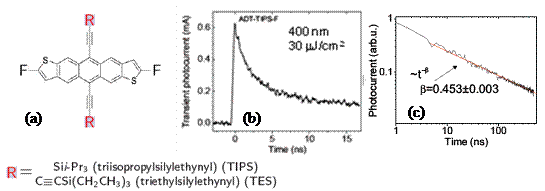

43989-G10
Charge Transfer in Organic Semiconductors: From Microscopic to Macroscopic Electronic Properties on all Time Scales
The goals of our project are to understand charge carrier dynamics in high-performance organic semiconductors and to lay foundations for charge-transfer-based single-molecule optoelectronic devices. Of particular interest is the relationship between macroscopic conductivity and microscopic charge-transfer rates. To achieve these goals, we use carefully designed organic semiconductors and time-resolved techniques including transient photocurrent and fluorescence spectroscopy in combination with single-molecule-level fluorescence imaging.
The materials suitable for our studies must exhibit: (i) high photoconductivity; and (ii) either strong, charge-sensitive, or complete lack of, fluorescence. After thorough testing of a number of organic semiconducting compounds that include various functionalized pentacene (Pc), functionalized anthradithiophene (ADT), and dicyanomethylenedihydrofuran (DCDHF) derivatives, we identified ADT-TIPS-F and ADT-TES-F derivatives (Fig. 1(a)) as most suitable nanoprobes of charge transfer. These ADT derivatives are high-performance solution-processable novel materials, which exhibit charge carrier mobilities of over 1.5 cm2/(Vs) in spin-coated thin-film transistors.
Our studies identified that ADT derivatives exhibit fast carrier photogeneration (<30 ps, limited by time resolution of our setup) under a 100-fs 400-nm laser pulse-excitation (Fig.1(b)) and long carrier lifetimes that allowed us to observe hole transport even at microseconds after 100-fs photoexcitation (Fig.1(c)). In addition, strong photoresponse, with current densities over 100 mA/cm2 at 0.4 mW/cm2, was observed under continuous wave (cw) excitation at 532 nm. Moreover, we demonstrated that by doping of ADT derivatives with other ADT derivatives, C60, Pc, or DCDHF, photoexcited charge carrier dynamics can be manipulated on different time scales. For example, enhancement of amplitude of the transient photocurrent, as well as speeding up or slowing down of the transient photocurrent decay in Fig. 1(b) can be achieved, depending on the dopant.
Strong fluorescence was observed in ADT solutions in toluene and in thin films, with quantum yields of over 70% and over 25%, respectively. Fluorescence spectra of thin films were strongly dependent on the molecular packing: while ADT-TIPS-F and ADT-TES-F derivatives had identical spectra in toluene solution, thin-film spectra were considerably different, due to differences in crystal structures assumed by these molecules in the solid state. In thin films, but not in solution, fluorescence quantum yield was strongly temperature dependent (Fig.2(a)), which highlights sensitivity of fluorescence emission of ADT derivatives to intermolecular interactions and changes in the environment.
In addition to enhanced optoelectronic properties of thin films based on ADT derivatives, ADT molecules could be imaged on a single-molecule level at room temperature using standard epi-fluorescence microscope (Figs.2(b) and (c)). Our ability to image these novel highly photoconductive molecules, whose fluorescence response is sensitive to their immediate nanoenvironment, represents a crucial step towards quantifying microscopic charge transfer.
Funding from the Petroleum
Research Fund (PRF) has been indispensable for establishment of organic
photonics and optoelectronics research program at Oregon State University. It
allowed us to build necessary experimental setups and to choose best candidates
for our studies from a variety of novel optoelectronic organic materials, to complete
studies of charge carrier dynamics in the bulk (ensemble) systems (macroscopic
conductivity in thin-film devices) and of fluorescent properties of derivatives
promising for microscopic-level studies, as documented in our recent
publications and conference presentations. Currently, we are exploring charge
carrier dynamics at a sub-micron level and pursuing several routes of
manipulation of the charged state of the ADT on the single molecule level. Results
obtained using the PRF funding allowed us to attract financial support for the
further development of this project from National Science Foundation through
the CAREER program (DMR-0748671), which undoubtedly will lead to new exciting
insights into charge transfer properties of organic semiconductors.


Figure 2. (a) Fluorescence spectra of an ADT-TIPS-F thin film at different temperatures. (b) Wide-field fluorescence image of ADT-TES-F molecules in PMMA matrix obtained under 532-nm excitation. White spots correspond to single ADT-TES-F molecules. (c) Fluorescence of a single ADT-TES-F molecule, with a characteristic single-step photobleaching, as a function of time.